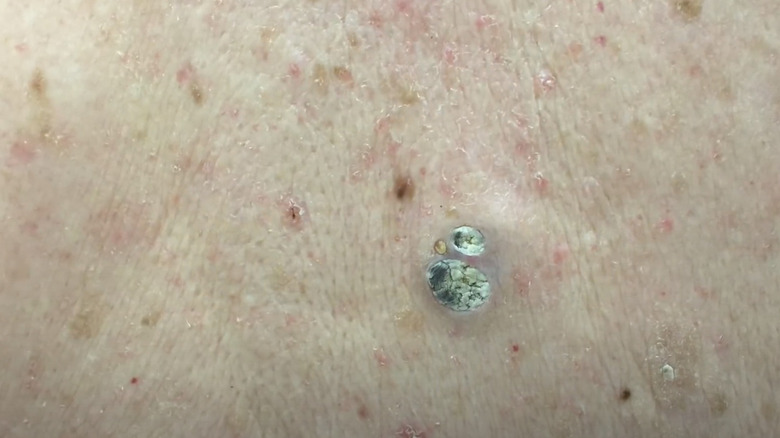What's A Dilated Pore Of Winer? The Acne Type, Explained
If you're a fan of watching pimple extraction videos, then you've likely come across a few dermatologists wrangling with what looks like an enlarged blackhead. In some cases, however, what resembles an apparent blackhead pimple may, in fact, be a type of benign tumor referred to as a dilated pore of Winer — after dermatologist Dr. Louis H. Winer, per Healthline.
According to the Cleveland Clinic, a dilated pore of Winer forms within a hair follicle or pore, and they can be found on most areas of the body, including the face, neck, and torso. These commonly occurring lesions look similar to a blackhead; however, they can grow much larger and are characterized by an exposed black "plug" in the center (via Healthline). This dark plug is composed of sebum and keratin and forms when dead skin cells clog the pore. The combined keratin and sebum then cause the pore to dilate or grow bigger, leaving it vulnerable to air exposure. When the pore material mixes with the oxygen in the air, it oxidizes and results in a darkened appearance. Thankfully, dilated pores of Winer are both commonly seen and easily treated.
Common treatment methods
Is it ever a good idea to squeeze out a blackhead or, in this case, a dilated pore of Winer? More often than not, the answer is "no." While frequent pimple poppers may be tempted to perform an at-home extraction, it increases the risk of infection and scarring if done incorrectly, as explained by dermatologist Dr. Andrea Suarez ("Dr. Dray") in a YouTube video.
Instead, book an appointment with a board-certified dermatologist, who will perform a minor excision — with localized anesthetic — to unclog and clean the pore. Another go-to treatment option uses a punch biopsy tool or a simple surgical needle to excise the dilated pore of Winer. In both cases, a dermatologist will then apply stitches to join the skin and encourage healing. Alternative methods for removing a dilated pore of Winer include laser removal or cryotherapy. However, Dr. Suarez explains that these newer methods may not fully remove the plug, which may cause the growth to return and increase the likelihood of scarring.
How to prevent a dilated pore of Winer
While dermatologists have yet to establish an exact cause for the formation of a dilated pore of Winer, Dr. Andrea Suarez explains in her YouTube video that some experts believe they form due to past inflammation. As a result, those with a history of inflammatory skin conditions, such as cystic acne, are more likely to develop these types of skin lesions.
The likelihood of a dilated pore of Winer returning after removal also exists if the lesion was not completely removed, per the Cleveland Clinic. This is another reason why you should seek out a professional, rather than attempting to extract it at home. That said, you can take certain precautions to prevent your pores from clogging and decrease the chance of developing a dilated pore of Winer. For instance, avoid skincare products that contain pore-clogging ingredients. Regularly exfoliating your skin to remove dead skin cell build-up will also prevent clogged pores. Pollution, certain clothing items, stress, humidity, and touching your face can all contribute to clogged pores as well, so addressing these lifestyle and environmental factors can help with prevention (via SkinTrust).
As sun damage is another leading cause of dilated pores of Winer, according to Dr. Suarez, remember to regularly apply sun protection to reduce the chance of sun damage. This is especially important for those with chronic acne or similar skin conditions that cause trauma to the pore's lining.


